
The Caproni Ca.1 was an Italian heavy bomber of the World War I era.
The Savoia-Marchetti SM.88, was an Italian twin-engined, three-seat, heavy fighter prototype of World War II, featuring a twin-boom structure, and powered by German Daimler-Benz DB 601 engines.

The Savoia-Marchetti SM.62 was an Italian single-engine maritime patrol flying boat produced from 1926. It served with the Regia Aeronautica and with a number of foreign users, and was licence-produced in Spain and the Soviet Union. Some of the Spanish aircraft were still in service during the Spanish Civil War

The Fiat G.12 was an Italian transport aircraft of World War II.
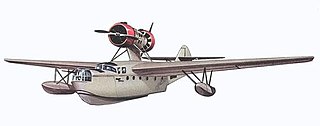
The Chyetverikov ARK-3 was a multi-role flying boat designed for Arctic operations that was built in the Soviet Union from 1933. It featured a conventional flying boat hull, with high cantilever wings equipped with floats at mid-span. The two piston engines were mounted in tractor-pusher fashion on a pylon above the fuselage.

The Fiat BRG was an Italian heavy bomber prototype built in the 1930s by Fiat for the Italian Air Force.
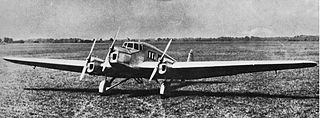
The Fiat G.2 was an Italian three-engine six-passenger monoplane transport aircraft designed by Giuseppe Gabrielli and built by Fiat.

The Fiat B.R. 1/4 was a light bomber series, developed in Italy shortly after World War I.

The Pomilio PE was a First World War Italian armed reconnaissance biplane designed and built by the Pomilio brothers. It was developed from the earlier Pomilio PC and PD.
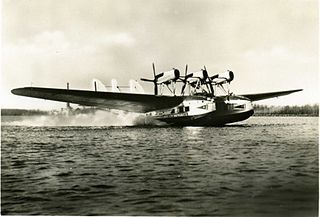
The Savoia-Marchetti S.66 was a 1930s Italian twin-hull flying boat designed and built by Savoia-Marchetti as an enlarged development of the S.55.

The Ikarus 451 is a family of research aircraft designs built in Yugoslavia in the 1950s, all sharing the same basic airframe, but differing in powerplants and cockpit arrangements. One member of the family Ikarus 451M became the first domestically-built jet aircraft to fly in Yugoslavia, on 25 October 1952.
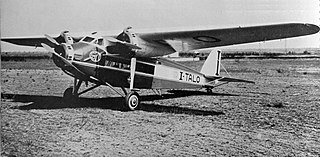
The Savoia-Marchetti S.71 was an Italian eight-passenger light transport designed and built by Savoia-Marchetti. The S.71 was a three-engine, high-wing cantilever monoplane with a fixed tailwheel landing gear. It had a crew of four and room for eight passengers. The first four aircraft were powered by three 190 kW (260 hp) Walter Castor II radial engines, but the last three had 276 kW (370 hp) Piaggio P.VII engines.
The Savoia-Pomilio SP.1 was a reconnaissance and bomber aircraft built in Italy during the First World War.
The Savoia-Pomilio SP.2 was a reconnaissance and bomber aircraft built in Italy during the First World War. It was a refined version of the SP.1, and like it, took its basic configuration from the Farman MF.11: a biplane with twin tails and a fuselage nacelle that accommodated the crew and a pusher-mounted engine. The SP.2 entered mass production with SIA, and with co-designer Ottorino Pomilio's own firm that he had recently established.
The Savoia-Pomilio SP.4 was a reconnaissance and bomber aircraft built in Italy during the First World War. It was a further development of the family of designs that had started with the SP.1. Ultimately all of these took their basic configuration from the Farman MF.11: a biplane with twin tails and a fuselage nacelle that accommodated the crew and a pusher-mounted engine. However, the SP.4 differed both from its Farman antecedent and the previous Savoia-Pomilio designs by featuring twin engines mounted in the interplane gap in place of the single engine in the nacelle. Removing the engine from this position allowed a second machine gun to be placed there instead.

The Yakovlev Yak-8 was a Soviet utility aircraft developed during World War II. It was not accepted for production, but received the NATO reporting name "Crib" anyway.

The Fiat BGA was an aircraft designed by Aldo Guglielmetti of the Italian Air Force.
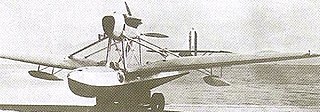
The SIAI S.67 or Savoia Marchetti SM.67 was an Italian flying boat fighter of the early 1930s designed and manufactured by SIAI.
The Anatra DE was a three-engined prototype Russian medium bomber of World War I. The biplane bomber was designed to hold four people. It was planned to use three engines to reach its target, then return using only one engine, having been lightened after dropping its payload. There was a single 140 hp Salmson engine at the front of the fuselage, and an 80 hp Le Rhône engine on each wing, which turned propellers attached to the rear of the engine, behind the wing. These engines were placed in a pusher configuration, and each wing also had a gun turret one each engine nacelle. In total, the aircraft had three guns, and could carry 400 kg of bombs. The only prototype that was built, weighing 327 kg more than expected, first flew on June 23, 1916. During testing, however, the fuselage and rear propellers became damaged when a tail skid broke, and it became evident that the design needed to be changed; the project was then abandoned.
The Caproni Ca.66 and Caproni Ca.67 were Italian night bomber aircraft designed to re-equip the post-World War I Regia Aeronautica.














